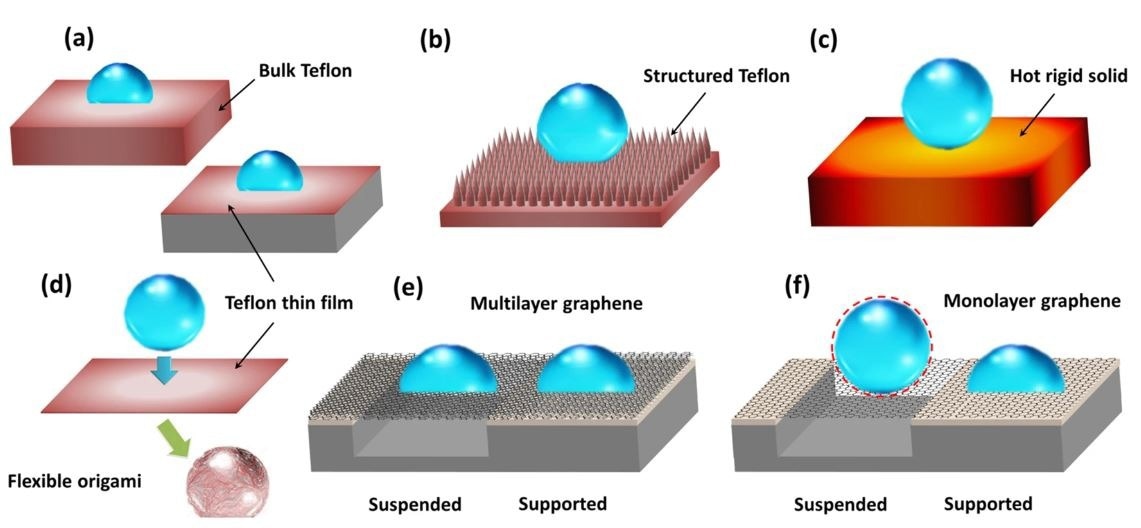Superhydrophobic materials are in great demand because they can be utilized in different high-end applications. The surface topography and chemical hydrophobicity of these materials play crucial roles in achieving superhydrophobicity.

a Non-wetting on bulk rigid Teflon™ and on surface coated with a thin film of Teflon™, b non-wetting on superhydrophobic structured Teflon™ bed of nails, c non-wetting on a very hot rigid material, d wetting of hydrophobic Teflon™ thin film wrapping itself around the droplet as in Capillary Origami20, e wetting on suspended and on supported multilayer graphene, and f wetting on supported monolayer graphene and non-wetting on suspended monolayer graphene where non-wetting droplet is highlighted by a red dashed circle. Image Credit: Wang, H et al. (2022)
An article published in Communications Materials demonstrated the formation of condensation-induced droplets with high non-wetting properties and contact angles of approximately 180 degrees on a graphene monolayer exposed to a humid environment on both sides.
The droplets were concurrently allowed to condense on monolayered (suspended and supported) and multilayered (suspended and supported) graphene to observe their non-wetting behavior. The results revealed that this behavior was exclusive to the suspended monolayer graphene.
The research findings suggest that high non-wetting behavior may occur because of the interactions among liquid molecules across the suspended monolayer graphene that was separated from the bulk substrate, producing higher non-wetting behavior than that on atomically flat or smooth hydrophobic supported monolayer surfaces.
What Are Superhydrophobic Materials?
Composite materials with superhydrophobic traits have been extensively studied because of their excellent characteristic properties, such as self-cleaning, hindered corrosion, and application in water-resistant electronic devices. The water-repellent properties of lotus leaves have motivated scientists to develop materials with exceptional water-repellency.
Superhydrophobic surfaces are facets with a water contact angle of 150 degrees or greater, and these materials are prepared with sufficient surface abrasion and minimum surface energy. The superhydrophobic regime is critical, as it experiences a perfect non-wetting capability with an exceptionally elevated water contact angle that results in the rolling of water droplets.
Graphene is an allotrope of carbon that was isolated via mechanical exfoliation in the early years of the 21st century. It is a monoatomic thin sheet of carbon arranged in a hexagonal honeycomb-like crystalline lattice. It has unique properties arising from its two-dimensional (2D) structure and the existence of sp2-bonded carbon atoms.
Graphene is anticipated to have a better future for fabricating various carbonaceous technical devices owing to its superior conductivity at room temperature and inertness to corrosion. The surface wettability of graphene has been extensively discussed in previous reports, and many efforts have been made to control it by modifying its surface.
Increasing the fraction of the liquid-vapor interface and replacing the solid-liquid interface is a common method to achieve super water repellency. The contact angles for different fluids on the flat surfaces were limited to 120 degrees.
However, the presence of micro- or nanostructures is a prerequisite for endowing surfaces with superhydrophobic qualities. These surfaces make capillary penetration unfavorable by manipulating the surface structure or inherent wettability of the outermost surface.
Condensation-Induced Droplets on Graphene Surface
In this study, graphene in the form of monolayers and multilayers was created on a patterned silicon substrate with trenches and holes. The suspended monolayer graphene showed wetting transparency with almost no interactions with water on the top.
Experimental observations of micrometer/picoliter droplets condensed on monolayer suspended graphene revealed non-wetting droplets with contact angles of 175 degrees, whereas wetting droplets with contact angles of approximately 90 degrees was observed on the supported monolayer and supported and suspended multilayered graphene.
Concurrent observations of the supported and suspended monolayer to multilayer graphene, and supplemental implications on sample quality and pinning revealed that the non-wetting of water droplets on a smooth monolayer, with contact angles larger than those of TeflonTM, could be feasible in the case of graphene by eliminating the water-surface interactions beyond the first surface layer.
Furthermore, as the water vapor molecules condensed, they created an ordered layer that interacted with each other on both sides of the suspended graphene. Thus, the condensing water molecules were protected from interactions with graphene, resulting in spherical droplets with low surface energy. This indicated that the highest contact angle achievable on a smooth hydrophobic surface was not restricted to that of TeflonTM.
Conclusion
In summary, the intrinsic wettability of suspended monolayer graphene was experimentally confirmed by observing condensing micrometer/picoliter droplets on the graphene monolayer. The experimental results validated the impact of surface topology on the contact angle, where non-wetting droplets with contact angles of 175 degrees were observed on a smooth, suspended graphene monolayer.
On the other hand, the droplets on the supported monolayer and suspended and supported multilayered graphene had contact angles below 90 degrees. The research findings indicated that removing the water-surface interactions beyond the first surface layer was favorable for realizing the non-wetting behavior of water droplets on a smooth graphene monolayer.
These findings offered a new path for controlling the wettability using suspended graphene. Nevertheless, further research is required on alternative monolayer materials that can be accomplished by manipulating the environment behind the suspended graphene layer, perhaps using microfluidics.
Reference
Wang, H et al. (2022). Non-wetting of condensation-induced droplets on smooth monolayer suspended graphene with contact angle approaching 180 degrees. Communications Materials. https://doi.org/10.1038/s43246-022-00294-8
Disclaimer: The views expressed here are those of the author expressed in their private capacity and do not necessarily represent the views of AZoM.com Limited T/A AZoNetwork the owner and operator of this website. This disclaimer forms part of the Terms and conditions of use of this website.